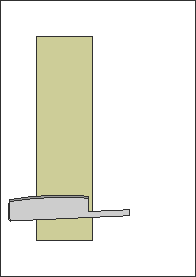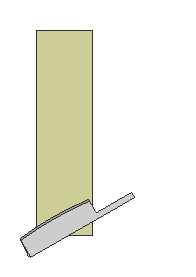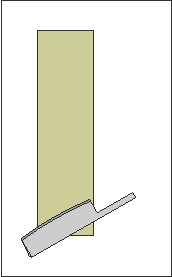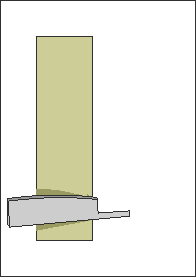Difference between revisions of "Strokes for honing a razor"
| Line 4: | Line 4: | ||
It is inherent to the production process that a straight razor may show small tolerances in the straightness of the blade and the evenness of the grind. As a result, even if the razor rest stable on a hone that's wide enough to support it completely, the edge may still not be touching the surface along its entire length. Even if a hone can and should be kept completely flat, the smallest amount of "dishing" will result in a less than perfect contact between edge and hone. | It is inherent to the production process that a straight razor may show small tolerances in the straightness of the blade and the evenness of the grind. As a result, even if the razor rest stable on a hone that's wide enough to support it completely, the edge may still not be touching the surface along its entire length. Even if a hone can and should be kept completely flat, the smallest amount of "dishing" will result in a less than perfect contact between edge and hone. | ||
For these reasons a strong recommendation must be made not to hone in a straight ahead direction, even if the hone is wide enough to support the entire blade. We simply have a better option that perfectly rules out these issues: the diagonal honing stroke, aka the X-stroke. | For these reasons a strong recommendation must be made not to hone in a straight ahead direction, even if the hone is wide enough to support the entire blade. We simply have a better option that perfectly rules out these issues: the diagonal honing stroke, aka the X-stroke. | ||
| − | The X-stroke | + | |
| + | === The regular X-stroke === | ||
| + | [[Image:Regular_X-stroke.gif]] | ||
| + | |||
For the majority of razors with a straight edge. This is the basic stroke for honing razors. Continually shifts the points of contact that the blade makes with the hone, compensating for small discrepancies in blade geometry and thus effectively assuring that the entire edge receives attention. | For the majority of razors with a straight edge. This is the basic stroke for honing razors. Continually shifts the points of contact that the blade makes with the hone, compensating for small discrepancies in blade geometry and thus effectively assuring that the entire edge receives attention. | ||
| − | The | + | |
| + | ---- | ||
| + | |||
| + | === The 45 degree X-stroke === | ||
| + | [[Image:45-stroke.gif]] | ||
| + | |||
For blades with a slight smiling curve at the edge, and blades that refuse to make good contact during the regular X-stroke. The heel stays a bit longer at the hone. | For blades with a slight smiling curve at the edge, and blades that refuse to make good contact during the regular X-stroke. The heel stays a bit longer at the hone. | ||
| − | + | ---- | |
| − | + | ||
| − | Image: | + | === The swooping stroke === |
| − | Image: | + | [[Image:Oblique_stroke.gif]] |
| − | + | ||
| − | + | For smiling edges. For blades with smiling spine and edge. The heel and toe receive some extra attention. | |
| + | |||
| + | ---- | ||
| + | |||
| + | === The Rolling X-stroke === | ||
| + | [[Image:Rolling_X-stroke.gif]] | ||
| + | |||
| + | For blades with light to heavily smiling edges. Adjust the tilt in the stroke accordingly. Can be combined with the swooping stroke. | ||
| + | |||
| + | ---- | ||
| + | |||
| + | == Practice and Training == | ||
| + | |||
| + | The edge is never better than your honing stroke. Even if you get everything else about honing a razor right, if your honing stroke is less than perfect, the resulting edge will be less than perfect too. Like many things related to straight razor use, it takes an amount of persistent practice to really master this. For adopting a good honing stroke it is better to practice 15 minutes daily than to spend one night weekly on a long and nerve-wracking honing session. Once the skill is yours, you won't easily loose it. Cerebral activities like riding a bike, using a computer mouse and honing razors, once learned generally stay with us for the rest of our lives. | ||
| + | |||
| + | == Visual aid == | ||
| + | |||
| + | The way the wave of fluid behaves in front of the edge, holds important information about your honing. If the fluid runs up a part of the edge, than you can be certain that part is making good contact with the hone and is keen enough to "undercut" the fluid. Parts of the edge that refuse to do this, ask for your special attention. Does that part make good contact with the hone? Is a good bevel fully developed? Do you need one of the special X-strokes to tackle problems with the blade geometry? Does your stroke needs fine-tuning? The wave in front of the edge helps to answer those questions. | ||
| + | If an edge misses a small micro-chip, that usually leaves a fine trail of honing fluid behind. If you spot this, it's always a good idea to closely examine the edge, preferably with some magnification device. | ||
| + | |||
| + | == Sonic aid == | ||
| + | |||
| + | If you accidentally lift the spine (something you should absolutely avoid), you'll be able to hear a sonic difference. Be honest with yourself when such a slip-up happens. It might be necessary to fall back to a previous hone for a few laps, to undo the microbevel you just created by lifting the spine. | ||
| + | When a small grain of a foreign substance ends up at the hone's surface, you can usually hear a grating sound. Stop immediately to clean the hone. | ||
| + | |||
| + | == Feedback == | ||
| + | |||
| + | Most of the things that can be heard can also be felt with the fingers that hold the razor. | ||
| + | Moreover, the way the edge is developing can be felt. This is called "feedback". Some types of hones offer a lot of feedback, while other types don't. Seasoned honers often rely more on the feedback than on dedicated sharpness tests. It takes a great deal of experience to acquire such level of mastery. | ||
| + | |||
--[[User:Bart|Bart]] 20:58, 8 January 2009 (UTC) | --[[User:Bart|Bart]] 20:58, 8 January 2009 (UTC) | ||
[[Category:Honing]] | [[Category:Honing]] | ||
Revision as of 19:23, 14 January 2009
If there's one thing easy about honing razors, it has to be the fact that they all come with a build-in honing jig. For sharpening the vast majority of knives, the challenging part is to maintain a correct honing angle. Many jigs and fixtures are available to attain this premise, none of which we need for straight razors. Razors simply lay flat on the hone. The honing angle is defined by the thickness of the spine and the width of the blade. The hollowness of the blade provides an arch that allows a steady, wobble-free movement of the blade. As a general rule, a razor is pushed over the hone with the edge leading. When it approaches the end of the hone, the razor is turned over the spine and pushed back to the starting position where it is flipped over the spine again. Such a complete movement is often called one lap. For achieving the delicacy of a good shaving edge, pressure must be kept minimal but even, throughout the entire action. Certain types of hones really show a reverse correlation between pressure and the keenness that can be reached. Diamond hones such as those made by DMT are an easily observable example of that, but they're not the only hones that ask for nominal pressure. It is inherent to the production process that a straight razor may show small tolerances in the straightness of the blade and the evenness of the grind. As a result, even if the razor rest stable on a hone that's wide enough to support it completely, the edge may still not be touching the surface along its entire length. Even if a hone can and should be kept completely flat, the smallest amount of "dishing" will result in a less than perfect contact between edge and hone. For these reasons a strong recommendation must be made not to hone in a straight ahead direction, even if the hone is wide enough to support the entire blade. We simply have a better option that perfectly rules out these issues: the diagonal honing stroke, aka the X-stroke.
Contents
The regular X-stroke
For the majority of razors with a straight edge. This is the basic stroke for honing razors. Continually shifts the points of contact that the blade makes with the hone, compensating for small discrepancies in blade geometry and thus effectively assuring that the entire edge receives attention.
The 45 degree X-stroke
For blades with a slight smiling curve at the edge, and blades that refuse to make good contact during the regular X-stroke. The heel stays a bit longer at the hone.
The swooping stroke
For smiling edges. For blades with smiling spine and edge. The heel and toe receive some extra attention.
The Rolling X-stroke
For blades with light to heavily smiling edges. Adjust the tilt in the stroke accordingly. Can be combined with the swooping stroke.
Practice and Training
The edge is never better than your honing stroke. Even if you get everything else about honing a razor right, if your honing stroke is less than perfect, the resulting edge will be less than perfect too. Like many things related to straight razor use, it takes an amount of persistent practice to really master this. For adopting a good honing stroke it is better to practice 15 minutes daily than to spend one night weekly on a long and nerve-wracking honing session. Once the skill is yours, you won't easily loose it. Cerebral activities like riding a bike, using a computer mouse and honing razors, once learned generally stay with us for the rest of our lives.
Visual aid
The way the wave of fluid behaves in front of the edge, holds important information about your honing. If the fluid runs up a part of the edge, than you can be certain that part is making good contact with the hone and is keen enough to "undercut" the fluid. Parts of the edge that refuse to do this, ask for your special attention. Does that part make good contact with the hone? Is a good bevel fully developed? Do you need one of the special X-strokes to tackle problems with the blade geometry? Does your stroke needs fine-tuning? The wave in front of the edge helps to answer those questions. If an edge misses a small micro-chip, that usually leaves a fine trail of honing fluid behind. If you spot this, it's always a good idea to closely examine the edge, preferably with some magnification device.
Sonic aid
If you accidentally lift the spine (something you should absolutely avoid), you'll be able to hear a sonic difference. Be honest with yourself when such a slip-up happens. It might be necessary to fall back to a previous hone for a few laps, to undo the microbevel you just created by lifting the spine. When a small grain of a foreign substance ends up at the hone's surface, you can usually hear a grating sound. Stop immediately to clean the hone.
Feedback
Most of the things that can be heard can also be felt with the fingers that hold the razor. Moreover, the way the edge is developing can be felt. This is called "feedback". Some types of hones offer a lot of feedback, while other types don't. Seasoned honers often rely more on the feedback than on dedicated sharpness tests. It takes a great deal of experience to acquire such level of mastery.
--Bart 20:58, 8 January 2009 (UTC)



